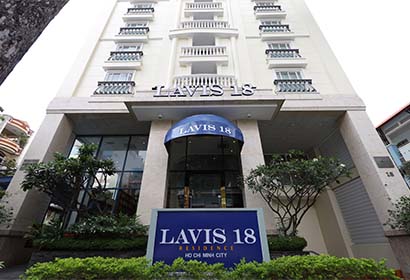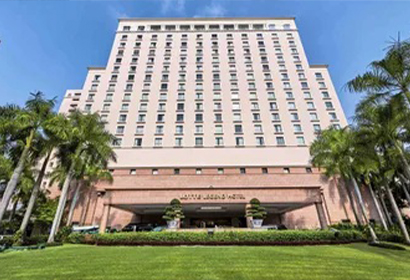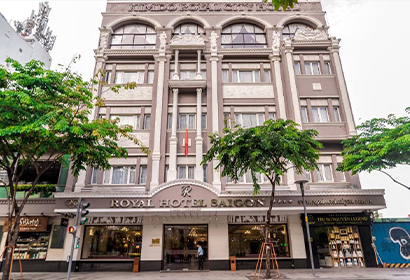Featured Holidays
33.5°C
Today (25-04-2025)
DEALS
HIGHLIGHTS

Cambodia is a land of breathtaking contrasts, where ancient temples stand alongside vibrant cityscapes. The most iconic highlight is Angkor Wat, the world’s largest religious monument, nestled in the sprawling Angkor Archaeological Park. This UNESCO World Heritage site is a testament to the grandeur of the Khmer Empire, with its intricate carvings and majestic towers. Phnom Penh, the capital, is a blend of history and modernity, with the Royal Palace, Silver Pagoda, and the sobering Tuol Sleng Genocide Museum offering insights into Cambodia’s rich yet tumultuous past. The serene town of Battambang and the coastal charm of Sihanoukville also add to Cambodia’s diverse allure.Embark on a journey through the ancient Angkor Archaeological Park. Marvel at Angkor Wat’s sunrise, explore the enigmatic faces of Bayon Temple, and wander through the jungle-covered Ta Prohm, where nature intertwines with stone.Beyond temples, explore the lively markets, vibrant arts scene, and traditional performances in Siem Reap. Take a boat trip on Tonle Sap Lake to visit the floating villages.
SEASONS TO TRAVEL
April
Hottest: 35°C Temperature
Coldest: 27°C Temperature
Average: 31°C Temperature
May
Hottest: 34°C Temperature
Coldest: 26°C Temperature
Average: 30°C Temperature
October
Hottest: 31°C Temperature
Coldest: 23°C Temperature
Average: 27°C Temperature
November
Hottest: 30°C Temperature
Coldest: 22°C Temperature
Average: 26°C Temperature
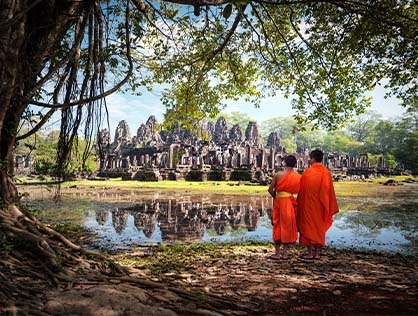
Dry Season (November to April): This period is considered the optimal time to visit Cambodia. The weather is warm and dry, making it ideal for exploring the country’s rich cultural sites and natural beauty.
From December to February, the cool season provides especially comfortable temperatures for sightseeing and outdoor activities, such as visiting the iconic Angkor Wat temples or relaxing on Cambodia’s pristine beaches. The dry weather also ensures clear skies and minimal disruption to travel plans, making it a popular time for tourists.
Rainy Season (May to October): The monsoon season brings lush landscapes and fewer tourists, creating a serene atmosphere. While frequent, heavy rains can be expected, they typically come in short, intense bursts, leaving plenty of dry intervals
CULTURE & TRADITIONS

Cambodia’s culture is profoundly shaped by its ancient history and deep-rooted Buddhist traditions. The Khmer New Year, celebrated in April, stands out as the country’s most significant festival. This vibrant event features traditional games, lively dance, and elaborate ceremonies, marking the lunar new year with joyful community gatherings and cultural rituals. Buddhism is a cornerstone of Cambodian life, with saffron-robed monks and serene pagodas evident throughout the nation. The presence of these monks and temples reflects the pervasive influence of Buddhism on daily activities and spiritual practices. The Apsara dance, a classical art form represented in ancient temple carvings, embodies the celestial nymphs from Hindu mythology. Local crafts, such as silk weaving and stone carving, are integral to Cambodian culture. These traditional skills, passed down through generations, not only showcase artistic talent but also play a crucial role in preserving the country’s cultural identity and supporting local artisans.
PREFFERED HOTELS
NATURE & WORTH A VISIT EXPERIENCE
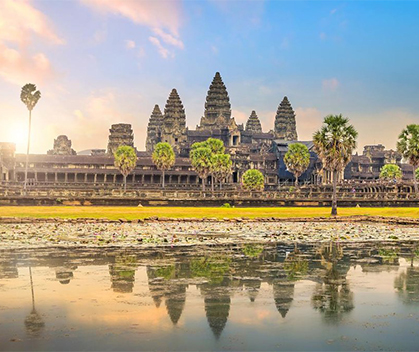
Angkor Archaeological Park
Angkor Archaeological Park, a UNESCO World Heritage Site, is a remarkable collection of ancient Khmer temples and ruins spanning over 162 hectares near Siem Reap, Cambodia. It is renowned for its awe-inspiring architecture and historical significance. The centerpiece, Angkor Wat, is the largest religious monument globally, celebrated for its intricate bas-reliefs and grand scale. The park includes other notable sites like Bayon Temple, famous for its enigmatic, smiling stone faces, and Ta Prohm, known for its dramatic intertwining tree roots. Exploring these ruins offers a glimpse into the grandeur of the Khmer Empire and its advanced engineering and artistic skills. The park's extensive history and stunning architecture make it a must-visit destination for history enthusiasts and travelers alike.
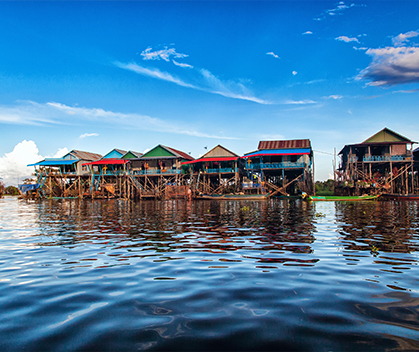
Tonle Sap Lake
Tonle Sap Lake, Southeast Asia’s largest freshwater lake, plays a crucial role in Cambodia’s ecology and economy. This expansive lake undergoes dramatic seasonal changes, expanding significantly during the monsoon rains and shrinking in the dry season. This unique hydrological phenomenon supports a diverse ecosystem, including a variety of fish species that are vital for local livelihoods. The lake is home to floating villages, where residents live and work on the water, offering a unique perspective on traditional Cambodian life. Visitors can experience boat tours, view floating markets, and witness the vibrant community life. The lake’s dynamic nature and cultural significance provide a fascinating contrast to Cambodia's urban and historical attractions.
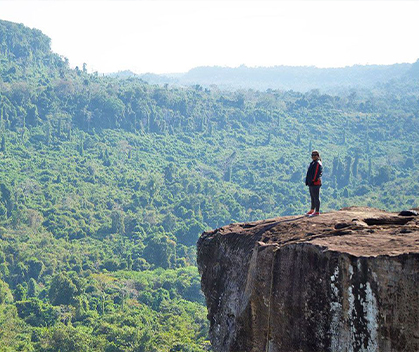
Kulen Mountain
Kulen Mountain, located approximately 50 kilometers north of Siem Reap, is a revered and picturesque destination in Cambodia, known for its profound spiritual and historical significance. This sacred site is highly regarded by Cambodians, who view it as a holy place. The mountain is renowned for its breathtaking natural beauty, highlighted by the striking Kulen Waterfall, a popular spot for visitors seeking a serene and refreshing escape. The area is also home to the River of a Thousand Lingas, where intricate carvings of Hindu deities are etched into the riverbed, symbolizing the divine and providing a glimpse into ancient Khmer religious practices. Pilgrims, historians, and tourists alike are drawn to Kulen Mountain for its rich blend of natural wonders, spiritual ambiance, and historical treasures.
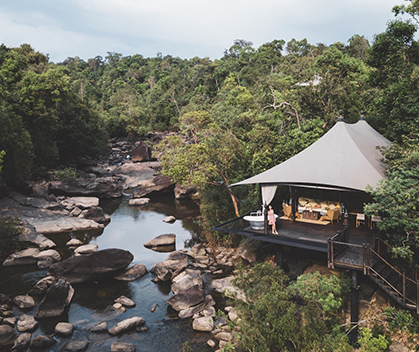
Cardamom Mountains
These Mountains are a striking and ecologically diverse mountain range. Covering roughly 4,000 square kilometers, this region is renowned for its rich biodiversity, including rare and endangered species such as the Indochinese tiger and the Asian elephant. The mountains are characterized by their rugged terrain, dense rainforests, and high levels of precipitation, creating an ideal habitat for a variety of flora and fauna. The area offers excellent opportunities for eco-tourism and adventure activities, including trekking, wildlife viewing, and exploring pristine forests. Conservation efforts are vital to preserving this unique environment, addressing threats like deforestation and habitat loss. The Cardamom Mountains stand out as a vital area for nature enthusiasts and conservationists, providing a stark contrast to Cambodia's urbanized regions and showcasing the country’s natural beauty and ecological importance.
FOOD PARADISE
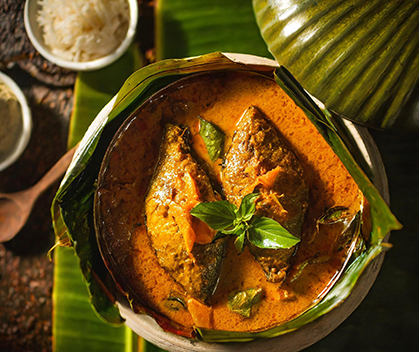
Amok Trey
Amok Trey is a beloved Cambodian dish renowned for its rich and aromatic flavors. This traditional curry features fish, usually catfish or tilapia, which is cooked in a velvety mixture of coconut milk and eggs. The dish is seasoned with a blend of fragrant spices, including lemongrass, galangal, and kaffir lime leaves, which contribute to its distinctive taste. Amok Trey is uniquely prepared by steaming the curry in banana leaves, which imparts a subtle, earthy flavor and helps retain the fish's moisture and tenderness. Typically served with steamed rice, the dish is garnished with fresh herbs and vegetables. The result is a harmonious blend of savory and slightly sweet flavors, making Amok Trey a quintessential example of Cambodian cuisine and a favorite among both locals and visitors.
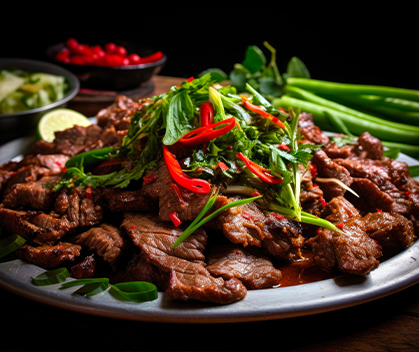
Lok Lak
Lok Lak is a classic Cambodian dish celebrated for its savory and tangy flavor profile. It consists of marinated beef cubes that are stir-fried with onions and bell peppers, creating a delicious and satisfying meal. The beef is typically marinated in a flavorful mixture of soy sauce, oyster sauce, and black pepper, which infuses it with depth and richness. Traditionally, Lok Lak is served with steamed rice, fresh vegetables, and a side of lime-pepper dipping sauce, which adds a zesty contrast to the savory meat. The dish is often topped with a fried egg, enhancing its heartiness and appeal. Lok Lak is cherished for its balanced flavors and straightforward preparation, making it a popular choice in Cambodian cuisine for both everyday meals and special occasions.
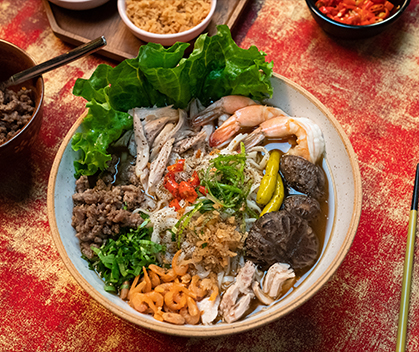
Kuy Teav
Kuy Teav is a cherished Cambodian noodle soup, celebrated for its comforting and savory qualities. This beloved dish features rice noodles immersed in a rich broth, simmered for hours with pork or beef bones to develop a deep, aromatic flavor. The soup is typically topped with slices of tender meat and garnished with fresh herbs such as cilantro and green onions. Accompanying the dish are bean sprouts, lime wedges, and chili peppers, which add a burst of freshness and a touch of heat. Often enjoyed as a breakfast or light meal, Kuy Teav offers a warm and nourishing experience. Its combination of flavorful broth, tender noodles, and vibrant garnishes makes it a staple of Cambodian cuisine, admired for its satisfying and comforting nature.

Prahok
Prahok is a quintessential Cambodian condiment renowned for its strong, distinctive flavor. This traditional fermented fish paste is crafted by salting and fermenting fish, typically mudfish, in clay jars for several months. The fermentation process produces a pungent, savory paste that adds significant depth and complexity to a variety of Cambodian dishes. Prahok is integral to many traditional recipes, enhancing soups, stews, and stir-fries with its robust flavor. Despite its intense aroma, Prahok is highly valued in Cambodian cuisine for its unique taste and cultural importance. It reflects the rich culinary heritage of Cambodia, where it serves as a staple ingredient in both everyday cooking and festive meals, embodying the essence of the nation’s traditional flavors and cooking practices.

